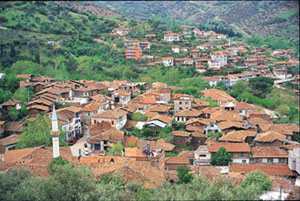|
|
|
|
|
 The little
town of Bademli about one hundred kilometres southeast of İzmir in western Turkey lies in
a green valley in the northern foothills of the Aydın Mountains. The history of the
region can be traced back to the Lydians, who were succeeded by the Persians and Hellenic
Greeks. In the second century BC it became part of the Roman Empire. In the middle ages
Bademli frequently changed hands between the Byzantines and the Turkish principalities,
finally coming under the rule of the Aydınoğulları Principality in 1308. The earliest
mention of Bademli in historical documents dates from 1327, when the Aydınoğulları
ruler İbrahim Bahadır was referred to as the lord of Bodamya, a name thought to
originate from the Greek Potamia, meaning land of the river, mentioned on a clay
tablet found in a field here. In the 17th century the Turkish writer and traveller Evliya Çelebi used the form Bademye, which in 1965 was
formally changed to Bademli.The attractions of the town itself are many charming old
houses and the Mosque of Kılcı Mehmet Ağa, distinguished by beautiful painted
decoration inside and out. Situated in the neighbourhood of Aşıklaroba, the mosque took
its present form when it was repaired and enlarged in 1810 by voivode of Ödemiş
Kılcızade Seyyit Mehmed Ağa (born 1747), after whom it was then named. The little
town of Bademli about one hundred kilometres southeast of İzmir in western Turkey lies in
a green valley in the northern foothills of the Aydın Mountains. The history of the
region can be traced back to the Lydians, who were succeeded by the Persians and Hellenic
Greeks. In the second century BC it became part of the Roman Empire. In the middle ages
Bademli frequently changed hands between the Byzantines and the Turkish principalities,
finally coming under the rule of the Aydınoğulları Principality in 1308. The earliest
mention of Bademli in historical documents dates from 1327, when the Aydınoğulları
ruler İbrahim Bahadır was referred to as the lord of Bodamya, a name thought to
originate from the Greek Potamia, meaning land of the river, mentioned on a clay
tablet found in a field here. In the 17th century the Turkish writer and traveller Evliya Çelebi used the form Bademye, which in 1965 was
formally changed to Bademli.The attractions of the town itself are many charming old
houses and the Mosque of Kılcı Mehmet Ağa, distinguished by beautiful painted
decoration inside and out. Situated in the neighbourhood of Aşıklaroba, the mosque took
its present form when it was repaired and enlarged in 1810 by voivode of Ödemiş
Kılcızade Seyyit Mehmed Ağa (born 1747), after whom it was then named.
But most eye-catching of all are the miniature style paintings on either side of the entrance, the one on the right depicting the Kaaba in Mecca and that on the left the tomb of Muhammed (Ravza-ı Mutahhara) in Medina.The interior of this small mosque is even more surprising. Almost every part of the walls are painted with tall green trees, red birds and colourful flowers, scenes evidently meant to represent paradise. The mosque is not domed, but has a flat ceiling with wooden beams. Other historic structures in Bademli are a single arch stone bridge over the Selli River and a ruined castle at Aktaş.
Although the nearby town of Birgi attracts many visitors who come here to see the old houses and lovely countryside, Bademli is known to only a few, perhaps because it is hidden away in its green valley. But this unspoilt little town is well worth a visit when you are in the area, particularly for those interested in vernacular architecture, to see the traditional houses and the delightful Kılcı Mehmet Ağa Mosque.
|
|
| |
Our Hotel | Turkey | Cappadocia | Daily Tours | Views | Guestbook | Request Form | Home |